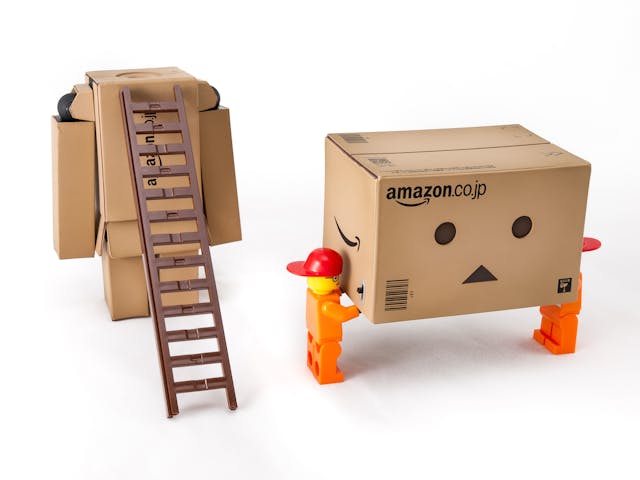Discover Amazon FBA: its definition, operational mechanics, and advanced strategies for e-commerce success. Explore how sellers leverage this platform’s logistics, optimize sales, and navigate competitive landscapes effectively.
The boundless world of e-commerce, where the art of selling meets the magic of the digital age. Today, I want to open the doors to a platform that has revolutionized the way we think about commerce: Amazon FBA. I want to show you how to best navigate this space. But remember, the real game will be played tranquilly on your personal e-commerce platform, where direct connections with your customers will be the cornerstone of your success.
As I walk you through the intricacies and opportunities of Amazon FBA, don’t lose sight of the fact that despite the bright lights of a global platform, what really matters is creating your own space in the marketplace . Here, the brand you have cultivated and the trust you have built will allow you to interact directly with the customer, showcase your uniqueness and collect the precious data that only a dedicated e-commerce can provide.
So, grab a coffee and get ready: we’re diving into the Amazon FBA ocean to navigate toward the safe harbor of your online business. Ready to set sail? Let’s embark together!
What is Amazon FBA?
The Fulfillment by Amazon program allows sellers to store their products in Amazon warehouses. Once a sale has been made, Amazon itself takes care of the packaging, shipping to the end customer and after-sales service , including customer support and, when necessary, returns management . For sellers, this brings significant benefits in terms of saving time and optimizing logistics .
Before we dive into how Amazon FBA works, it’s important to understand the basics of this service and how it impacts sellers who choose to use it.

How Amazon FBA Works
The Amazon FBA program is based on a few key steps that are essential to understand for anyone who wants to start this type of business.
The first step is to create a seller account on Amazon and select the FBA plan. Subsequently, the seller sends their products to Amazon’s distribution centers, where they are cataloged and stored waiting to be sold.
When a customer purchases an FBA product, Amazon takes care of the picking, packing, and shipping process. Sellers can track everything through the Seller Central platform, which provides detailed information about inventory and sales.
An extremely useful feature for sellers is the ability to monitor inventory levels in real time, which allows them to schedule timely restocking without running into stock-out situations.
Thanks to the FBA program, sellers’ products also become eligible for Amazon Prime, increasing the visibility and attractiveness of their items, as well as customer trust thanks to the promise of fast and timely deliveries that Prime guarantees.
Best Practices for Optimizing Your Amazon FBA Program
To maximize the effectiveness of using the Amazon FBA program, it is essential to adopt some best practices. First of all, an accurate choice of product is crucial: an analysis of the market and demand will help in selecting items with good sales performance and attractive margins.
Listing optimization is another critical step; using SEO techniques, sellers can improve the visibility of their products within the Amazon ecosystem. This includes curating titles, descriptions, bullet points, and images, as well as using keywords relevant to customer searches.
Another important practice is review management: by encouraging positive feedback (naturally in compliance with Amazon guidelines) and promptly responding to negative feedback in a constructive way, sellers can improve their ranking and the reputation of their brand.
And last but not least, careful financial management, including understanding Amazon FBA costs (such as storage and shipping fees), is essential to keeping your business profitable .

Advanced strategies to optimize sales on Amazon FBA
Sellers operating under Amazon FBA must always keep a close eye on how to optimize their sales. One of the most advanced strategies is to leverage the data provided by Amazon to analyze market trends and adjust the offer accordingly. Analyzing detailed reports provided in Seller Central can offer insights into which products sell best and at which times of the year, allowing sellers to plan targeted promotions and optimize inventory based on demand.
Another focal point is price management: using automatic repricing tools can help you stay competitive, adjusting prices reactively to market fluctuations and competitor strategies.
An often overlooked but vital aspect is the quality of customer service. Amazon FBA takes care of most of the logistics, but the seller must ensure that the customer service, for questions not handled directly by Amazon, is of a high standard. This includes the speed in responding to questions, clarifications and in handling special situations that Amazon does not directly cover.
Advanced strategies for optimizing sales on Amazon FBA, exploring some tactics and techniques those sellers can adopt to increase performance and maximize profits.
Competitive Analysis and Product Positioning
A key part of being successful on Amazon understands the market and your competitors. Use competitive analysis tools to monitor the pricing, promotions, and sales strategies of other sellers in your product category. Understanding how your products stack up in terms of price, quality, and brand perception is essential to defining a value proposition that sets you apart from the competition.
SEO and PPC optimization
Visibility is a key consideration on Amazon. Search Engine Optimization (SEO) on and off Amazon can dramatically improve the chances of your products being found by potential customers. This includes a multi-faceted approach that ranges from keyword optimization on your product page to building external links to your listing.
In parallel, use Amazon’s pay-per-click (PPC) advertising, such as Amazon Sponsored Products, to gain extra visibility. Setting up and optimizing targeted advertising campaigns can get your product in front of highly interested customers.
Leveraging Data to Predict Demand
Amazon provides a wealth of data and insights through Seller Central. Use this to better understand purchasing patterns and optimize your inventory accordingly. Sophisticated use of this information can help you predict seasonal trends and respond to fluctuations in demand in real time.
Creating Packages, Upselling and Cross-Selling
Offering bundles and bundles of related products on Amazon FBA can increase perceived value and drive higher sales. Stimulates combined purchases (“frequently bought together”) with offers that encourage upselling and cross-selling, maximizing the value transferred to each individual customer.
Programming and Automation
Automate where possible, from dynamic pricing to analyzing your listing performance. There are numerous apps and tools that can help you stay responsive in Amazon’s dynamic marketplace, from automatic repricing to systems that monitor review trends.
Added Value and Brand Building
In Amazon’s competitive environment, building a strong brand and providing added value can be a great differentiator. Consider including informational and educational materials in your listings, or offer exceptional customer service. These aspects can improve your brand image and build customer loyalty.
Attention!
Investing in these advanced strategies will take time and resources, but can lead to a significant competitive advantage on Amazon FBA. It is important for sellers to maintain a data-driven, customer-centric approach, as well as proactive management of their product portfolio and marketing campaigns to continue to grow and succeed in the Amazon FBA space.
Amazon FBA Inventory Storage Fees
A critical component of the Fulfillment by Amazon (FBA) program is inventory holding fees, which can significantly impact the cost structure of sellers using this service. To best manage these costs and maintain profitability, it is essential to understand how these fees are calculated and what strategies can be employed.
Commission Calculation
Amazon FBA storage fees are determined by several factors, including the physical size of the product and the length of storage. Typically, Amazon charges these fees on a monthly basis based on the physical volume (in cubic feet) that the inventory occupies in fulfillment centers.
Different times of the year can lead to varying storage costs, with rates generally higher during peak sales months, such as those proceeding the year-end holidays. This is due to the increased demand for storage space during these periods.
Additionally, inventory that remains in Amazon’s warehouses for extended periods of time (usually more than 6 months) may be subject to additional overstocking fees. This is to discourage sellers from overloading fulfillment centers with products that do not sell quickly.
Strategies to Optimize Custody Fees
To optimize these costs, sellers must have an effective inventory management system. This includes scheduling regular, measured shipments of products to distribution centers, rather than large quantities that may not sell in a short time.
Another aspect to consider is the analysis of product salability. If some items tend to remain unsold for long periods, it may be appropriate to reduce the quantities sent or consider liquidation strategies, such as discounts or promotions, to speed up their sale.
Wise sellers carefully monitor on-hand inventory, paying particular attention to items near the 6-month storage mark. Amazon offers detailed reports that can help sellers identify such products and make necessary operational decisions.
Additionally, a seasonal inventory management strategy can be helpful , especially if the products you offer have seasonal demand patterns. Anticipating these patterns and reducing inventory during off-peak periods can significantly reduce your stocking fees.
Inventory holding fees are an essential part of Amazon FBA’s service model, and managing them effectively can make the difference between a successful operation and one that struggles to maintain profitability. A thorough understanding of warehousing fees and practices, along with a proactive inventory strategy, will ensure sellers can make the most of the opportunities Amazon offers while keeping costs under control.
Conclusion
And so, dear digital friend, our immersion in Amazon FBA comes to an end, but in reality, your journey into the world of e-commerce is just changing course. The strategies and insides that you have acquired, which are powerful tools, but keep in mind that it is through your e -commerce that you will be able to play the game with all the cards in your hand.
In your digital ecosystem, you are the one collecting invaluable data, which will allow you to fully understand the behavior of your customers, their preferences, the paths that brought them to you and what makes them come back. Furthermore, you have the opportunity to build a direct, intimate and personalized relationship with those who choose your products, maximizing the value of your brand.
Weaving a sales strategy that combines the logistics efficiency of Amazon FBA with the intimacy and personalization of your e-commerce means choosing the path to success. This blend empowers you to take the reins of your business, guiding your audience exactly where you want them to go and offering unique experiences that foster customer loyalty to your brand.
While Amazon provides incredible visibility and broad reach, remember the power and value of owning your space. It serves as a foundation for targeted advertising and marketing strategies that authentically reflect your brand identity.
We look forward to hearing your distinctive voice in the market; the world is hungry for your uniqueness. Never stop exploring new horizons and remember: every click on your site is a seed planted in the fertile soil of customer engagement. It’s time to cultivate the garden of your online presence and reap the fruits that are sure to come.
Good luck, and remember that your next customer could be right around the corner, browsing your brand , looking for that perfect shopping experience that only you can offer.








